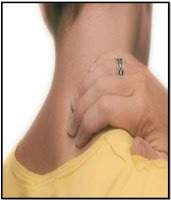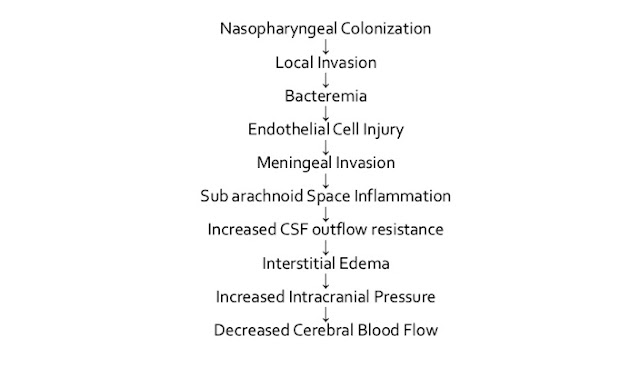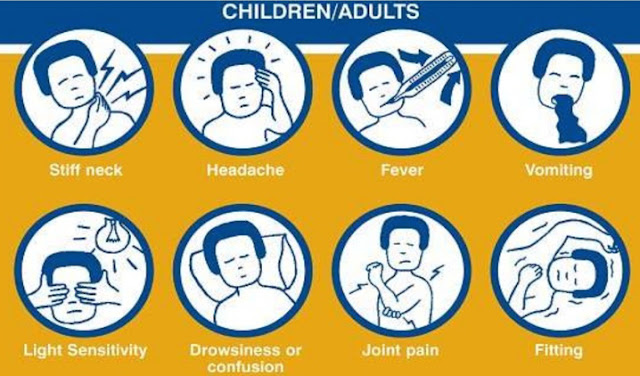Meningitis is the infection and inflammation of the meninges (covering of the brain and spinal cord: duramater, arachnoid and piamater) and the cerebrospinal fluid.
Etiology
Bacterial
- Bacillus sp.
- Bacteroides
- Borrelia burgdorferi (Lyme disease)
- Other Enterobacteriaceae
- Escherichia coli
- Haemophilus influenzae
- Listeria monocytogenes
- Mycobacterium tuberculosis
- Mycoplasma
- Meisseria meningitidis
- Proteus
- Pseudomonas aeruginosa
- Staphylococcus aureus
- Streptococci
- Streptococcus pneumoniae
- Treponema (syphilis)
- Others
Fungi
- Biastomyces
- Candida
- Cladosporium
- Coccidioides
- Cryptococcus
- Histoplasma
- Paracoccidioides
- Others
Parasites
- Amoebae
- Taenia solium (cysticercosis)
- Toxoplasma gondii
- Others
- Meningeal infection associated with a dural leak secondary to neurosurgery or neurotrauma - S.pneumoniae, Staphylococcus aureus, P. aeruginosa, coliform bacteria.
- Viral meningitis- Enteroviruses are statistically most commonly -Causes of “nonparalytic polio”
- Fungal and parasitic meningitides -immunocompromised.
Causative Agents
- Neisseria meningitis
Incubation period: 2-10 days
- Haemophilus influenza
Incubation period: 1-4 days
- Enteroviruses
Incubation period: 3 to 7 days
Classification
- According to etiology
- Bacterial( meningococcal, pneumococcal, staphylococcal)
- Viral
- Fungal
- Protozoal
- Partially
- Purulent meningitis
- Serous meningitis
- Depending upon pathogenesis
- Primary
- secondary
- According to course of disease
- Fulminant
- Acute
- subacute
- Chronic
- According to severity
- Mild
- Moderate
- Severe
- very severe
Pathophysiology
Signs and symptoms
- Syndrome of infectious disease
Fever, Fatigue, Myalgia
- Meningeal symptoms
- General cerebral (Headache, vomiting, psychomotor agitation, seizure , impaired consciousness )
- Acute meningeal symptoms (general hyperesthesia, hypersensitivity of sense organ, tonic muscle tension, reactive pain phenomenon)
- Nuchal rigidity:
 |
| Nuchal rigidity |
It is the inability to flex the head forward due to rigidity of the neck muscles; if flexion of the neck is painful but full range of motion is present, nuchal rigidity is absent.
- Kernig's sign positive
 It is positive when the leg is bent at the hip and knee at 90 degree angles, and subsequent extension in the knee is painful (leading to resistance).
It is positive when the leg is bent at the hip and knee at 90 degree angles, and subsequent extension in the knee is painful (leading to resistance).- Brudzinski’s sign
Diagnostic Procedure
- Lumbar Puncture (Increase Protein and WBC# Low Sugar level)
A lumbar puncture takes samples of the fluid around the spine and brain, known as cerebral spinal fluid (CSF). A culture of the spinal fluid is done to check for organisms known to cause illness.
- Blood Culture
A blood culture is a test on a sample of blood to check for bacteria in the bloodstream; it may be done if a doctor suspects a blood infection. A blood culture may be helpful in determining the specific bacteria causing an infection and selecting the appropriate antibiotic to treat it.
- Imaging (X-rays and CT scans)
X-rays and computerized tomography (CT) scans of the head, chest or sinuses may reveal swelling or inflammation. These tests can also help your doctor look for infection in other areas of the body that may be associated with meningitis.
Meningitis drug of choice
Antibiotics:
- Ampicillin, Third-generation Cephalosporin such as Ceftriaxone or Ampicillin and an Aminoglycoside.
- Other drugs include Digitalis glycoside such as Digoxin (to control arrhythmia), Mannitol (to decrease cerebral edema) or a Sedative (to reduce restlessness) and Aspirin or Acetaminophen (to relieve headache and fever).
Medical Management
- Vancomycin Hydrochloride in combination with one of the Cephalosporins is administered IV.
- Dexamethasone (Decadron)
- Dehydration and shock are treated with fluid volume expanders.
- Phenytoin (Dilantin)- treatment for seizures if occurs.




Post a Comment
If you have any doubts, please let me know